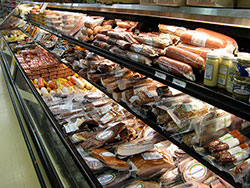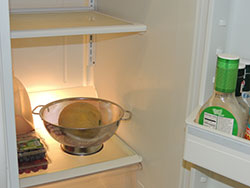by H. Thigeel, P. Kendall, and M. Bunning* (10/11)
Quick Facts…
- Listeriosis, the disease caused by Listeria monocytogenes, is a life-threatening disease for individuals with compromised immune systems.
- Listeria not only survives but can grow at refrigeration temperatures.
- Refrigerated ready-to-eat (RTE) foods are commonly linked to listeriosis outbreaks.
- Proper handling and storage of refrigerated foods and fresh produce is one way to control Listeria.
What is Listeriosis?

Listeria monocytogenes causes listeriosis, an uncommon but potentially fatal disease in immunocompromised individuals. Listeriosis has become an important public health problem in the U.S. The pathogen has increasingly been implicated in recalls of perishable ready-to-eat foods. Although the incubation period can be as long as 2 months, symptoms generally begin 3 days to 3 weeks after eating contaminated foods and can include fever, muscle aches, diarrhea, headache, stiff neck, confusion and convulsions; miscarriages and stillbirths may occur in pregnant women. Organs that may be affected by listeriosis include the uterus during pregnancy, the central nervous system, and the blood stream. Infection with Listeria is life-threatening and primarily affects newborn infants, pregnant women, the elderly, and those with compromised immune systems. The death rate of listeriosis among these individuals is high, from 20-25% if untreated.
Disease Characteristics
Listeria monocytogenes causes two forms of listeriosis: non-invasive gastrointestinal listeriosis and invasive listeriosis. In immune-compromised individuals such as the elderly and patients receiving immunosuppressive drugs, listeriosis can cause septicemia (presence of bacteria in the blood) or meningoencephalitis (inflammation of the membranes covering the brain and spinal cord). Fever is generally present in patients with septicemia, which is often associated with severe illness. Other nonspecific flu-like symptoms such as fatigue, abdominal pain, and nausea may also occur. Invasive listeriosis can also be acquired by the fetus from its infected mother via the placenta.
Organism Characteristics
Listeria monocytogenes is a hardy bacterium which has several unique survival characteristics compared to other microorganisms that cause foodborne disease. Listeria is widely distributed in nature. The bacterium is found in the normal flora of the GI tracts of cattle, sheep, poultry, birds, fish, insects, cats and dogs. It is excreted in the fecal material and has been found in samples of soil, stale water supplies, silage, dust, animal hides and manure. It can also be transferred from these sources to plants and contaminate fresh produce.
Foodborne Listeriosis
Within the last 25 years, food has been recognized as a primary mode of transmission of Listeria monocytogenes in humans. Several outbreaks of listeriosis have been associated with the consumption of perishable foods that require refrigeration. These foods are often referred to as refrigerated ready-to-eat foods because they are designed to be eaten without cooking, like deli salads and luncheon meats. As one example, soft, unripened Mexican-style cheese made with unpasteurized (raw) milk was the source of a listeriosis outbreak in 1985 that affected 142 persons in California. The majority of cases (65%) involved pregnant women or their offspring, mostly of Hispanic descent. Among the other infected adults, nearly all had a known predisposing condition that compromised their immune system.

Vegetables have the potential to become contaminated with Listeria in the growing environment from the soil or contact with animal manure. Animals can carry the bacteria without appearing ill. Produce-associated Listeria outbreaks have been linked to several types of vegetables and fruits including cabbage, celery, and lettuce. In 2011, cantaloupes were associated with one of the largest and most deadly outbreaks of listeriosis in the U.S.
Listeria is destroyed during the pasteurization process; however, there is potential for post-processing contamination of milk with Listeria through contact with unpasteurized milk or contaminated equipment. Although there is a low rate of consumption of raw milk in the United States where the Federal law requires pasteurization of milk sold through interstate commerce, some states allow the purchase of unpasteurized milk.
Deli meats and uncooked or undercooked frankfurters have been the cause of several outbreaks of listeriosis in the U.S. In 1988, invasive listeriosis was linked to consumption of contaminated turkey frankfurters. This was the first laboratory-confirmed association of meat and poultry products with invasive listeriosis. The largest listeriosis outbreak in the United States occurred in 1998-1999 due to the consumption of contaminated frankfurters and deli meats. In 2008, deli meats were again implicated in a large outbreak of listeriosis in Canada.
Smoked seafood products also have been associated with listeriosis. Cold smoking of fish and other seafood does not provide sufficient heat treatment to inactivate Listeria, if present. Smoked fish and seafood have been linked to several outbreaks, involving such foods as smoked mussels, rainbow trout, smoked salmon, and smoked cod roe.
Control and Prevention of Listeria
Since the recognition of food as the primary mode of transmission, a wide variety of food types have been implicated in outbreaks of Listeria monocytogenes. These foods are capable of supporting the growth and multiplication of Listeria. In fact, many of these foods are cured, pasteurized or cooked in the production process and then exposed to post-processing contamination from the environment. A common characteristic of many implicated foods is that they are refrigerated ready-to-eat. Table 1 shows types of foods that are commonly associated with Listeria and safety measures consumers should follow to help control Listeria.
It’s important to keep ready-to-eat items separate from uncooked meats and unwashed produce during purchase and refrigerated storage. Read and follow label instructions to “keep refrigerated” and “use by” a certain date. Listeria monocytogenes can grow in foods in the refrigerator; keeping the temperature of your refrigerator between 35°F-40°F can help to slow the growth of Listeria.
Washing hands well before and after working with food can help prevent listeriosis as well as other diseases. Risk of exposure to Listeria monocytogenes from cross contamination can also be prevented by thoroughly cleaning and sanitizing cutting boards and other kitchen surfaces. Chlorine bleach is a commonly used sanitizer that can be effective against Listeria monocytogenes. Use 1 scant teaspoon of chlorine bleach per quart of water to sanitize cleaned surfaces. Two other household products that can be effective against Listeria on food contact surfaces are hydrogen peroxide (available in 3% concentration) and distilled white vinegar (available in 5% concentration).
Cooking foods thoroughly will destroy any Listeria that may be present on the food. Pregnant women should heat deli and luncheon meats to steaming hot before eating. This includes packaged lunch meats and those purchased at the deli. You can use a microwave, oven or grill. If cold lunch meats are preferred, the lunch meats can be heated and then cooled before eating. Antibiotics can be used to treat listeriosis. There is no vaccine for the disease.
| Table 1: Food safety tips for preventing listeriosis among high risk indviduals. | |
| Food | To reduce risk: |
| Meats, lunch meats and hot dogs | Refrigerate meat products as soon as possible after purchasing. Thoroughly cook all meats, poultry and seafood. Avoid refrigerated meat spreads or pates. Canned meat spreads are safe to eat. Reheat hot dogs and luncheon meats to 165˚F or until steaming hot. Freeze meats, lunch meats and hot dogs that you are not planning to consume within 4 days of purchase or preparation. If opened food can’t be frozen or reheated before eating, discard after 4 days in the refrigerator. |
| Fish and seafood | Do not eat cold smoked fish or raw or undercooked seafood. Instead choose canned fish or fish heated to steaming hot. |
| Dairy foods | Do not drink raw milk or eat soft cheeses made with raw milk such as queso fresco, Feta, Brie, Camembert and blue-veined cheese. Cream cheese, cottage cheese, and aged cheeses, like cheddar or Swiss are safe to eat. |
| Deli-style salads | Salads from deli counters are considered risky, especially if made with potentially hazardous ingredients like smoked seafood. Store-bought mayonnaise is safe to use in making salads if properly handled and refrigerated. |
| Fruits & Vegetables | Rinse all raw produce well with cold running water before eating. The surface of melons should be scrubbed well under running water with a clean vegetable brush and dried with a clean cloth or paper towel before cutting to prevent bacteria from being spread to the cut surface. Discard cut vegetables after 4 hours at room temperature. Avoid eating raw sprouts, like alfalfa and radish sprouts. Avoid drinking unpasteurized fruit juices, such as raw apple cider. |
| Leftovers | Refrigerate or freeze cooked leftovers in small, covered shallow containers (2 inches deep or less) within two hours after cooking. Use cooked leftovers within 4 days. Don’t taste to determine safety. If in doubt, throw it out. |
Factors that increase Listeria’s threat to human health include its ability to:
- Grow at refrigeration temperatures, 32˚F and above.
- Grow in an acidic (as low as 4.4 pH) or basic (as high as pH 9.6) environment.
- Tolerate low moisture environments; it has been detected in hard fermented salami.
- Grow under anaerobic conditions (without oxygen) at refrigeration temperatures. L. monocytogenes is a facultative anaerobe microorganism. It prefers O2, but can tolerate anaerobic environments. This property makes Listeria a potential threat to the safety of foods packaged under vacuum or modified atmospheres as the growth of this microorganism is not inhibited in vacuum packaged food items.
- Grow at extremely high salt concentrations, especially at refrigerator temperatures. It has been detected in commercial cheese brines. Thus, cheese brines should be considered as potential sources for cross-contamination.
- Attach to a wide variety of surfaces, including stainless steel, glass, wood, porcelain, iron, plastic, polyester, propylene, rubber, waxed cardboard, and paper. Attachment of Listeria to a solid surface may be followed by the formation of extracellular polysaccharide layers, called biofilms, which serve as physical barriers to protect the bacteria within them. Listeria biofilms cannot be seen with the naked eye. Once they are formed, they can be very difficult to remove. Due to Listeria’s ability to attach to different surfaces, packaging materials can be a potential source of contamination.
Other CSU Extension fact sheets in this series include:
- 9.300, Bacterial Food-Borne Illness, P. Kendall
- 9.305, Botulism, P. Kendall
- 9.369, E. Coli Prevention from Garden to Plate, J. Davis and P. Kendall.
References and Resources
Allerberger, F. & Wager, M. 2010. Listeriosis: a resurgent foodborne infection. Clinical Microbiology and Infectious Diseases, 16, 16-23.
Centers for Disease Control and Prevention. Listeriosis. Available from: www.cdc.gov/listeria/index.html. Accessed 9/30/11.
Dean, J. and P. Kendall. Food Safety during Pregnancy. 2006. Colorado State University Extension Fact Sheet # 9.372. Available from: http://extension.colostate.edu/topic-areas/nutrition-food-safety-health/food-safety-during-pregnancy-9-372/.
Liu, D. (Ed.) 2008. Handbook of Listeria monocytogenes. New York: Taylor and Frances Group.
Ryser, E., & Marth E. (Eds.) 2007. Listeria, Listeriosis, and Food Safety, 3rd Ed. New York: Marcel Dekker.
Photo credit: HarvesTime Foods – sausage case, captaincinema, Flickr: https://www.flickr.com/photos/captaincinema/3828552780/
*H. Thigeel, Colorado State University, graduate student, department of food science and human nutrition; P. Kendall, associate dean of research, college of applied human sciences; M. Bunning, Extension food safety specialist and assistant professor. Colorado State University, U.S. Department of Agriculture, and Colorado counties cooperating.
CSU Extension programs are available to all without discrimination. No endorsement of products mentioned is intended nor is criticism implied of products not mentioned
Go to top of this page.





